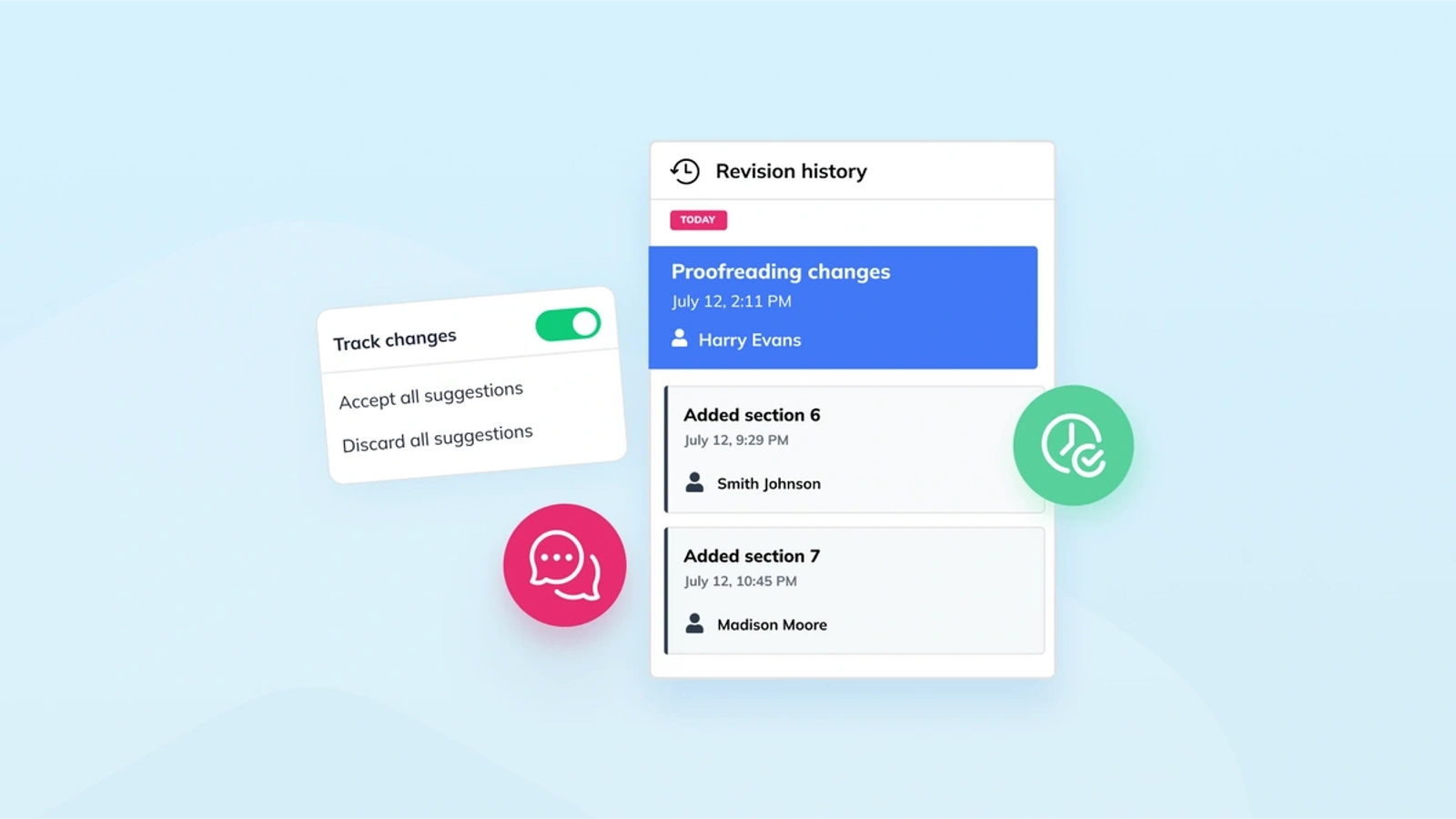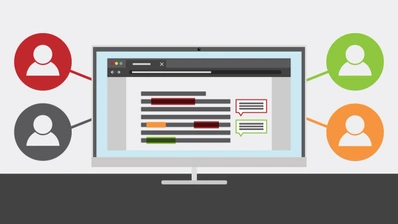Asynchronous collaboration: Navigating the future of teamwork

Working together is easier than ever, right? With messaging apps, digital whiteboards, video calls and online task boards, you can collaborate with colleagues anywhere, anytime. Most people are having significantly more meetings now than they were in 2020. So why does it feel like genuine teamwork has become harder? The solution is fewer meetings and more asynchronous collaboration.
With remote and hybrid work on the rise – 58% of Americans are doing it – fostering closer collaboration is a priority for most companies. Gartner found 71% of HR leaders are more concerned about collaboration than they were pre-pandemic. But more remote work and greater collaboration don’t always go hand-in-hand.
While real-time communication tools like Zoom can stand in for the face-to-face collaboration in an office, it can also lead to what Harvard Business Review calls collaboration overload, where colleagues spend more time in conversation than they do working. The real opportunity posed by the growth of remote work is asynchronous collaboration – working separately, but not siloed.
Asynchronous collaboration is the future of teamwork, and it’s increasingly the present, too.
Before we get into what asynchronous collaboration is, we need to talk about what it isn’t. Specifically, how asynchronous work reveals the contrast between communication vs collaboration.
Communication vs collaboration: understanding the difference
Communication and collaboration are intertwined, but they’re not synonymous. Collaboration involves actively working together on a task, while communication is simply sharing information. Despite this, so many discussions about collaboration best practices are really just about communicating more.
Rick Kick and Kennedy Collins from Thoughtworks, a tech consultancy, offer the following definition:
Teams that meet regularly to discuss their work are communicating. Teams that openly seek and provide input while actively working are collaborating. Having regular status meetings where teams give updates on different components doesn’t mean a team is collaborative. Collaboration happens when teams actively try to understand each other and openly seek and provide input while working.
In other words, more communication doesn’t mean more collaboration.
Communicating more, collaborating less
When you look at it that way, the danger of confusing communication with collaboration becomes clear. So-called ‘collaboration overload’ is really communication overload – endless unstructured meetings and message threads that don’t lead to a common goal or greater understanding.
That’s why working together often feels harder in a remote team. When communicating with any colleague doesn’t even require you to leave your desk, it’s easy to fall into the trap of talking more but collaborating less.
This is especially true for collaboration between different teams. Microsoft research found that company-wide remote work caused a drop in collaboration between teams, but an increase in communication within teams. When working remotely, people spent more time talking to their teammates and less time working together with other colleagues.
There’s no question that effective collaboration in real-time, either in-person or via video, can lead to better results. But real-time communication – especially when it’s unscheduled or unstructured – is a major distraction from focused work. Properly managed, asynchronous collaboration is the solution to this dilemma.
What is asynchronous collaboration?
Asynchronous collaboration is when people work together on the same project, but not at the same time. Colleagues keep to their own schedules and communicate when they can. Just like real-time collaboration depends on good real-time communication, asynchronous collaboration depends on good asynchronous communication.
But what is asynchronous communication? If you’ve ever sent an email to a colleague in a different time zone or sent a Slack message to someone who was offline and answered you later, you’ve used asynchronous communication. Any type of conversation that doesn’t require all participants to engage at the same time is asynchronous. From comments in a Google Doc to audio messages and forum threads, most online forms of communication are, or can be, asynchronous.
Despite that, companies tend to push for real-time teamwork over asynchronous collaboration, favoring the apparent speed of results. But the asynchronous route has several advantages over its real-time alternative.
Synchronous vs asynchronous collaboration: faster isn’t always better
It might seem like collaborating all at the same time is more efficient than dragging discussion out over days or weeks. This makes sense when everyone’s in the same office, but as soon as meetings have to cater to different time zones and locations, they lose many of their advantages over asynchronous communication.
If people from the Boston office and the Sydney office want to chat, they have to overlap when it’s night for one group and early morning for the other. Those aren’t the times of day when you can expect to see everyone at their best. And time differences don’t have to be that large for the same issues to occur. As Gartner reports, peak productivity for each person varies throughout the day, meaning one person’s ideal collaboration time is another’s downtime.
Add to that the fact that poorly run meetings typically drag on beyond the time necessary for good collaboration. Even if they finish on time, ineffective meetings generally require follow-up meetings to handle work that was missed the first time around. It’s no wonder only 17% of executives say meetings are usually a productive use of time.
In contrast, asynchronous collaboration is the workplace equivalent of thinking before you speak. It gives everyone involved a chance to focus on the task and contribute when they have the time and bandwidth to do it properly.
That’s not to say real-time video meetings and calls have no place in a remote team. Urgent tasks sometimes require quick, focused real-time collaboration. But studies show that a 40% reduction in the number of meetings can increase overall productivity by 71%. And that’s just one benefit of going asynchronous.
5 key benefits of asynchronous collaboration
Working asynchronously unlocks a number of productivity and organizational benefits. Here’s a quick snapshot:
-
Increased engagement by allowing people to contribute when they’re at their most productive and focused.
-
Fewer meetings means greater flexibility for all team members to manage their own schedules.
-
It’s easier to support distributed and diverse teams, so you can hire the best people, not just the best ones near the office.
-
Asynchronous communication means better documentation of important decisions and more careful briefings than in a typical meeting.
-
With fewer interruptions to work, it’s easier to implement other productivity boosts like ‘no meeting Wednesdays’ or golden hours for more focused work.
Now let’s take a look at some of the best tools to use to kickstart your asynchronous teamwork.
Key tools for effective asynchronous collaboration
Almost all productivity and communication tools today can support asynchronous collaboration. Instead of an exhaustive list of them all, let’s focus on a few basics you’ll need no matter what tools you use.
Clear expectations for asynchronous work
Ultimately, the tools and platforms you use for asynchronous collaboration are less important than the structure and culture you build around them. Messaging apps like Slack and Teams are great for working asynchronously, but only if they don’t become a neverending virtual meeting with no agenda.
Fully distributed companies like Buffer have addressed this with a set of 10 company-wide norms for using Slack. Highlights include giving people explicit permission to block notifications when they need to focus, and setting clear expectations that Slack messages should be answered by the end of the day.
It might sound like overkill to set ground rules – but email has been in workplaces since the 90s and the average person still interrupts work to check their emails 15 times a day. The best way to avoid your shiny new collaboration apps ending up as just another distracting inbox is to make it clear from the start that they’re for asynchronous collaboration.
Recorded meetings
You’ll never eliminate video meetings altogether, but you can make them much more effective by recording them for later consumption. For starters, it saves wrangling with time zones – anyone who’s available can have the meeting in person and those who aren’t can catch up later.
Some meeting recorder apps can also transcribe and summarize the meeting to make it easier to find key info.
But slimming down the invite list also makes the meeting more efficient for its participants. Research shows the ideal number of attendees for a productive meeting is eight or less, and if the meeting is recorded, you only need to invite people who can definitely contribute to the discussion.
A collaborative whiteboard
Brainstorming and planning sessions don’t need to be real-time anymore, either. Virtual whiteboard apps like Miro and FigJam support both real-time and asynchronous collaboration. Colleagues can make changes and leave comments at a time that suits them, so strategy sessions benefit from everyone’s best, most focused input.
Shared documents
A must-have for remote teams of any kind, shared documents that can be collaboratively edited are especially important for asynchronous work. Instead of emailing different drafts, everybody can contribute in one place. All the standard features of apps like Google Docs are key inclusions: comments for leaving feedback, track changes to make suggestions, and document history to see what’s been edited.
Integrate a purpose-built rich text editor
Another must-have is a purpose-built collaborative editor, like CKEditor. It’s a modern rich text editor specifically built for collaboration – it offers limitless customization and integrates with a wide range of tech stacks. Using apps with CKEditor’s collaborative WYSIWYG functionality, you get all the most important features for asynchronous collaboration.
Multiple people can edit the same content together. Plus, colleagues can join the discussion with Mentions and Comments, contribute their thoughts using Track Changes, and keep on top of feedback with Revision History. It’s like having Google Docs inside your app.
Build asynchronous collaboration into all your tools
Don’t forget, your internal tools should also support asynchronous collaboration. Whether it’s a CRM, CMS, or LMS, any (or all) of your platforms can level up when you add collaboration functionality with a purpose-built collaborative editor, like CKEditor. Rather than employing external tools for their collaboration features, bring a Google Docs-style experience to your own apps, with a collaborative WYSIWYG experience.
CKEditor 5 is a modern rich text editor built for collaboration. A Premium subscription includes asynchronous collaboration features like Comments, Track Changes, and Revision History. Contact us now to start swapping your meetings for meaningful work.


